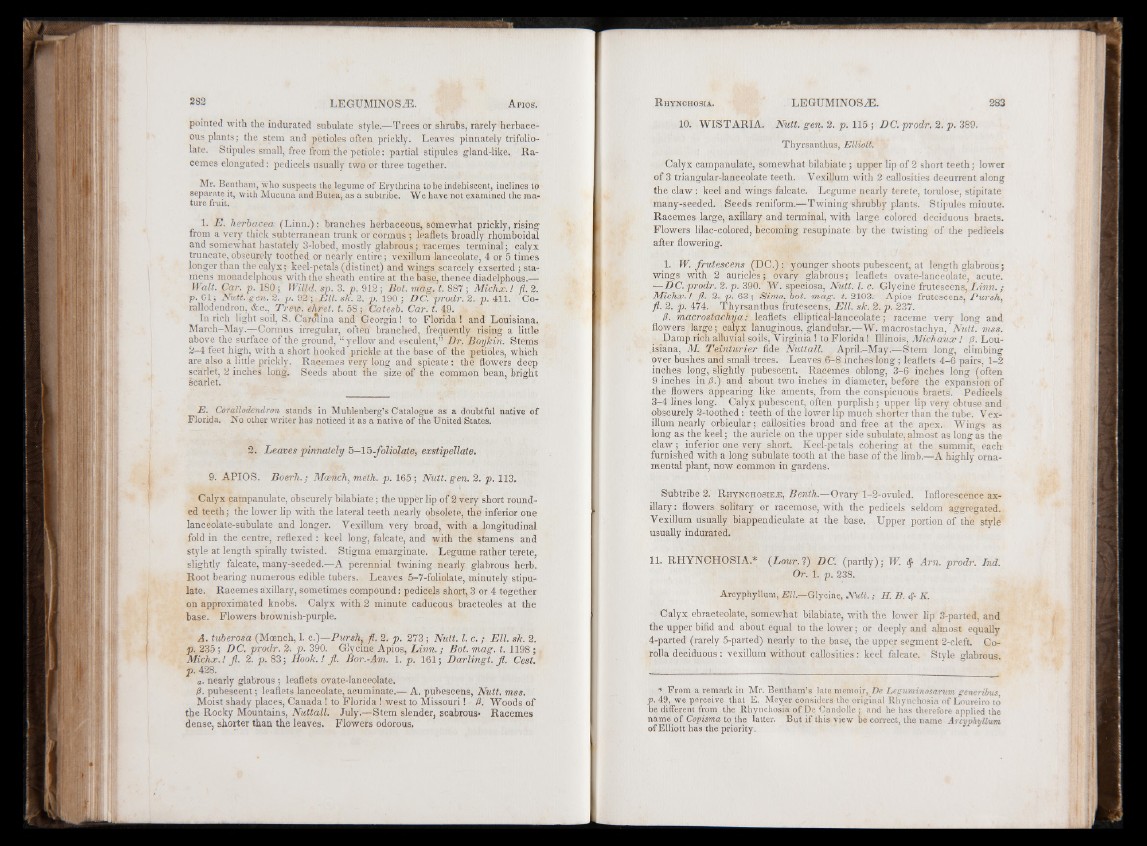
pointed with the indurated subulate style.—Trees or shrubs, rarely herbaceous
plants; the stem and petioles often prickly. Leaves pinnately trifolio-
late. Stipules small, free from the petiole: partial stipules gland-like. Racemes
elongated: pedicels usually two or three together.
Mr. Bentham, who suspects the legume of Erythrina to be indehiscent, inclines to
separate it, with Mucuna and Butea, as a subtribe. We have not examined the mature
fruit.
1. E. herbacea (Linn.): branches herbaceous, somewhat prickly, rising
from a very thick subterranean trunk or cormus ; leaflets broadly rhomboidal
and somewhat hastately 3-lobed, mostly glabrous; racemes terminal; calyx
truncate, obscurely toothed or nearly entire; vexillum lanceolate, 4 or 5 times
longer than the calyx; keel-petals (distinct) and wings scarcely exserted ; stamens
monadelphous with the sheath entire at the base, thence diadelphous.—
Walt. Car. p. ISO; Willd. sp. 3. p. 912 ; Bot. mag. t. 887 ; Michx.! fl. 2.
p. 61; Nutt. gen. 2. p. 92 ; Ell. sk. 2. p. 190 ; DC. prodr. 2. p. 411. Co-
rallodendron, &c., Trew. ehret. t. 58; Catesb. Car. t. 49. |
In rich light soil, S. Carolina and Georgia! to Florida ! and Louisiana.
March-May.—Cormus irregular, often branched, frequently rising a little
above the surface of the ground, “ yellow and esculent,” Dr. Boykin. Stems
2-4 feet high, with a short hooked prickle at the base of the petioles, which
are also a little prickly. Racemes very long and spicate: the flowers deep
scarlet, 2 inches long. Seeds about the size of the common bean, bright
scarlet.
E. Corallodendron stands in Muhlenberg’s Catalogue as a doubtful native of
Florida. No other writer has noticed it as a native of the United States.
2. Leaves pinnately 5—15-foliolate, exstipellate.
9. APIOS. Boerh.; Mceiich, meth. p. 165; Nutt. gen. 2. p. 113.
Calyx campanulate, obscurely bilabiate; the upper lip of 2 very short rounded
teeth; the lower lip with the lateral teeth nearly obsolete, the inferior one
lanceolate-subulate and longer. Vexillum very broad, with a longitudinal
fold in the centre, reflexed : keel long, falcate, and with the stamens and
style at length spirally twisted. Stigma emarginate. Legume rather terete,
slightly falcate, many-seeded;^—A perennial twining nearly glabrous herb.
Root bearing numerous edible tubers. Leaves 5-7-foliolate, minutely stipulate.
Racemes axillary, sometimes compound: pedicels short, 3 or 4 together
on approximated knobs. Calyx with 2 minute caducous bracteoles at the
base. Flowers brownish-purple.
A. tuberosa (Moench, 1. c.y^Piershf fl. 2. p. 273 ; Nutt. 1. c .; Ell. sk. 2.
p . 235 ; DC. ppodr. 2. p. 390. Glycine Apios, L in n .; Bot. mag. t. 1198 ;
Michx.I Jl. 2. p. 83; Hook.! Jl. Bor.-Am. 1. p. 161; Darlingt.fi. Cest.
p . 428.
a. nearly glabrous ; leaflets ovate-lanceolate.
0. pubescent; leaflets lanceolate, acuminate.— A. pubescens, Nutt. mss.
Moist shady places, Canada ! to Florida ! west to Missouri! 0. Woods of
the Rocky Mountains, Nuttall. July.—Stem slender, scabrous- Racemes
dense, shorter than the leaves. Flowers odorous.
10. WISTARIA. Nutt. gen. 2. p. 115 ; DC. prodr. 2. p. 389.
Thyrsanthus, Elliott. !
Calyx campanulate, somewhat bilabiate ; upper lip of 2 short teeth; lower
of 3 triangular-lanceolate teeth. Vexillum with 2 callosities decurrent along
the claw: keel and wings falcate. Legume nearly terete, torulose, stipitate
many-seeded. Seeds reniform.-—Twining shrubby plants. Stipules minute.
Racemes large, axillary and terminal, with large colored deciduous bracts.
Flowers lilac-colored, becoming resupinate by the twisting of the pedicels
after flowering.
1. W. frutescens (DC.): younger shoots pubescent, at length glabrous;
wings with 2 auricles; ovary glabrous; leaflets ovate-lanceolate, acute.
— DC. prodr. 2. p. 390. W. speciosa, Nutt. l. c. Glycine frutescens, Linn. ;
Michx.! fl. 2. p. 63; Sims. bot. mag. t. 2103. Apios frutescens, Pursh,
fl. 2. p. 474. Thyrsanthus frutescens. Ell. sk. 2. p. 237.
P. macrostuchya: leaflets elliptical-lanceolate; raceme very long and
flowers large; calyx lanuginous, glandular.—W. macrostachya, Nutt. mss.
Damp rich alluvial soils, Virginia ! to Florida! Illinois, Michaux ! 0. Louisiana,
M. Teinturier fide Nuttall. April.-May.—Stem long, climbing
over bushes and small trees. Leaves 6-8 inches long; leaflets 4-6 pairs, 1-2
inches long, slightly pubescent. Racemes oblong, 3-6 inches long (often
9 inches in 0.) and about two inches in diameter, before the expansion of
the flowers appearing like aments, from the conspicuous bracts. Pedicels
3 - 4 lines long. Calyx pubescent, often purplish; upper lip very obtuse and
obscurely 2-toothed: teeth of the lower lip much shorter than the tube. Vexillum
nearly orbicular ; callosities broad and free at the apex. Wings as
long as the keel; the auricle on the upper side subulate, almost as long as the
claw; inferior one very short. Keel-petals cohering at the summit, each
furnished with a long subulate tooth at the base of the limb.—A highly ornamental
plant, now common in gardens.
Subtribe 2. R hynchosieje, Benth.—Ovary 1-2-ovuled. Inflorescence axillary
: flowers solitary or racemose, with the pedicels seldom aggregated.
Vexillum usually biappendiculate at the base. Upper portion of the style
usually indurated.
11. RHYNCHOSIA* (Lour.'!) DC. (partly); W. # Am. prodr. Ind.
Or. 1. p. 238.
Arcyphyllum, Ell.—Glycine, Nutt. ; H. B. <p K.
Calyx ebracteolate, somewhat bilabiate, with the lower lip 3-parted, and
the upper bifid and about equal to the lower; or deeply and almost equally
4- parted (rarely 5-parted) nearly to the base', the upper segment 2-cleft. Corolla
deciduous: vexillum without callosities : keel falcate. Style glabrous.
* From a remark in Mr. Bentham’s late memoir, Be Leguminosarum generibus
p. 49, we perceive that E. Meyer considers the original Rhynchosia of Loureiro to
be different from the Rhynchosia of De Candolle ; and he has therefore applied the
name of Copisma to the latter. But if this view be correct, the name Arcyphyllum
of Elliott has the priority.